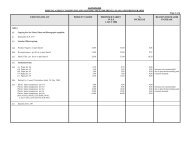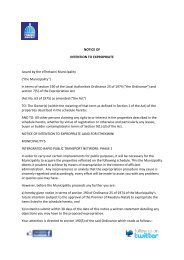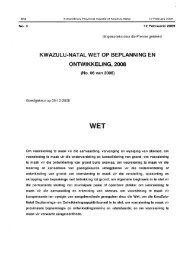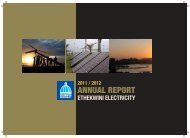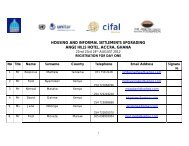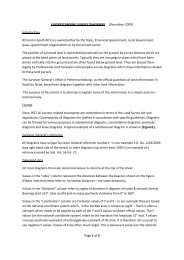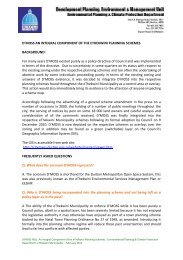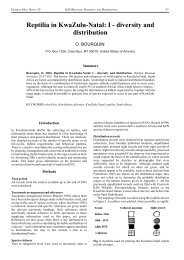Mullin, S. K., Taylor, P. J. & Pillay, N. 2004. Skull size and ... - Durban
Mullin, S. K., Taylor, P. J. & Pillay, N. 2004. Skull size and ... - Durban
Mullin, S. K., Taylor, P. J. & Pillay, N. 2004. Skull size and ... - Durban
Create successful ePaper yourself
Turn your PDF publications into a flip-book with our unique Google optimized e-Paper software.
MULLIN_08 13/08/04 12:45 Page 23<br />
defined groups with material from the west,<br />
southwest <strong>and</strong> northeast more similar to D. rufulus<br />
<strong>and</strong> material from the east more similar to east<br />
African Dasymys. The morphometric separation<br />
seen within the DRC was not dependent on<br />
geographical distances between the populations<br />
(i.e. isolation by distance), but rather the distinctions<br />
in skull <strong>size</strong> <strong>and</strong> shape more likely reflect<br />
previous environmental <strong>and</strong>/or biogeographical<br />
restrictions (Davis 1962; Happold 1996; Verheyen<br />
et al. 1996). Musser & Carleton (1993) considered<br />
D. i. bentleyae (from southwest DRC) as a synonym<br />
within D. incomtus despite workers suggesting<br />
that D. i. bentleyae represented a valid species<br />
(Cabrera & Ruxton 1926; Allen 1939; Schouteden<br />
1948; Sanborn 1952; Crawford-Cabral & Pachecho<br />
1989). Our study partially confirms the assessment<br />
made by Musser & Carleton (1993) in that it showed<br />
that D. i. bentleyae should retain its current status,<br />
but we suggest that D. i. bentleyae represents a<br />
synonym within D. rufulus rather than D. incomtus.<br />
The taxonomic position of material from central<br />
east Africa (Zambia, Malawi, Mozambique <strong>and</strong><br />
Tanzania) was not entirely clear in this study.<br />
One certainty was that the data showed that<br />
Dasymys from this region were not similar to the<br />
nominate D. incomtus from the KwaZulu-Natal<br />
Province of South Africa, indicating that these<br />
specimens are incorrectly named as D. incomtus.<br />
It was apparent that some central east African<br />
Dasymys (particularly specimens from Mozambique)<br />
shared cranial similarities with Dasymys from East<br />
P R O O F<br />
Africa. Although, faunal links have been well<br />
established between east <strong>and</strong> central east Africa<br />
(e.g. Carcasson 1964; Happold & Happold<br />
1989; Poynton 1990; Stuart et al. 1993; Burgess<br />
et al. 1998), it appears that east <strong>and</strong> central east<br />
African Dasymys examined in this study have<br />
been isolated from each other for a significant<br />
period of time. Carcasson (1964), Happold &<br />
Happold (1989), <strong>and</strong> Stuart et al. (1993) further<br />
hypothesised that central Africa provided a faunal<br />
link between west <strong>and</strong> central east Africa. This<br />
appears to have more importance for Dasymys as<br />
central east African specimens seem to have a<br />
skull <strong>size</strong> <strong>and</strong> shape more similar to west African<br />
D. rufulus than to Dasymys from east Africa.<br />
MAMMALIA • 2004 • 68 (2)<br />
African Dasymys systematics<br />
The fifth species listed by Musser & Carleton<br />
(1993), D. incomtus, occupies a much smaller range<br />
than suggested. Dasymys incomtus is currently<br />
listed as occurring in Chad, southern Sudan,<br />
Ethiopia, Cameroon, Central African Republic,<br />
the DRC, Ug<strong>and</strong>a, Kenya, Rw<strong>and</strong>a, Burundi,<br />
Tanzania, Angola, Zambia, Malawi, Mozambique,<br />
Zimbabwe <strong>and</strong> South Africa (Meester et al. 1986;<br />
Carleton & Musser 1993). Instead, the data provided<br />
here indicated that D. incomtus would be<br />
confined to Zimbabwe <strong>and</strong> South Africa although<br />
the relationship between Zimbabwe specimens<br />
<strong>and</strong> South African D. i. incomtus was not clear.<br />
Dorsal skull data suggested they represent three<br />
distinct groups, the ventral skull shape showed<br />
Zimbabwe specimens to be in-between the<br />
KwaZulu-Natal <strong>and</strong> the Limpopo <strong>and</strong> Mpumalanga<br />
Province specimens <strong>and</strong> similar to material from<br />
Zambia, Malawi (Zomba <strong>and</strong> Mulanje) <strong>and</strong><br />
Mozambique (Zambue), while traditional data<br />
showed a connection between south-western<br />
Zimbabwe (representing D. i. fuscus) <strong>and</strong> KwaZulu-<br />
Natal Province of South Africa. Despite the ambiguity<br />
of these data, the Limpopo <strong>and</strong> Mpumalanga<br />
Province OTUs were distinct from all other<br />
material <strong>and</strong> never grouped with KwaZulu-Natal<br />
Province material (although both groups represent<br />
D. i. incomtus senso lato). We feel this is significant<br />
in that it emphasises the karyotypic <strong>and</strong><br />
electrophoretic differences within D. i. incomtus<br />
shown by Gordon (1991) <strong>and</strong> <strong>Mullin</strong> et al. (2002).<br />
Three subspecies are recognised in South Africa<br />
<strong>and</strong> Zimbabwe (excluding D. i. capensis which<br />
will be discussed separately below): D. i. incomtus,<br />
D. i. fuscus <strong>and</strong> D. i. nudipes (southwestern<br />
Zambia <strong>and</strong> northwestern Zimbabwe; Fitzsimons<br />
1920; Smithers & Wilson 1979; Meester et al.<br />
1986; Crawford-Cabral & Pacheco 1989;<br />
Skinner & Smithers 1990). Crawford-Cabral &<br />
Pacheco (1989) examined cranial differences<br />
between D. i. incomtus (from the Limpopo <strong>and</strong><br />
Mpumalanga Provinces) <strong>and</strong> D. i. fuscus <strong>and</strong> suggested<br />
they represented allospecies; we found<br />
similar results. Dasymys i. incomtus has also been<br />
listed as possibly occurring in Mozambique <strong>and</strong><br />
Malawi (Smithers & Tello 1976; Meester et al.<br />
1986; Skinner & Smithers 1990), which contrasts<br />
23



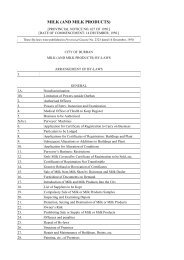
![INK Environmental Sustainability Booklet [19 MB] - Durban](https://img.yumpu.com/22025104/1/190x136/ink-environmental-sustainability-booklet-19-mb-durban.jpg?quality=85)

